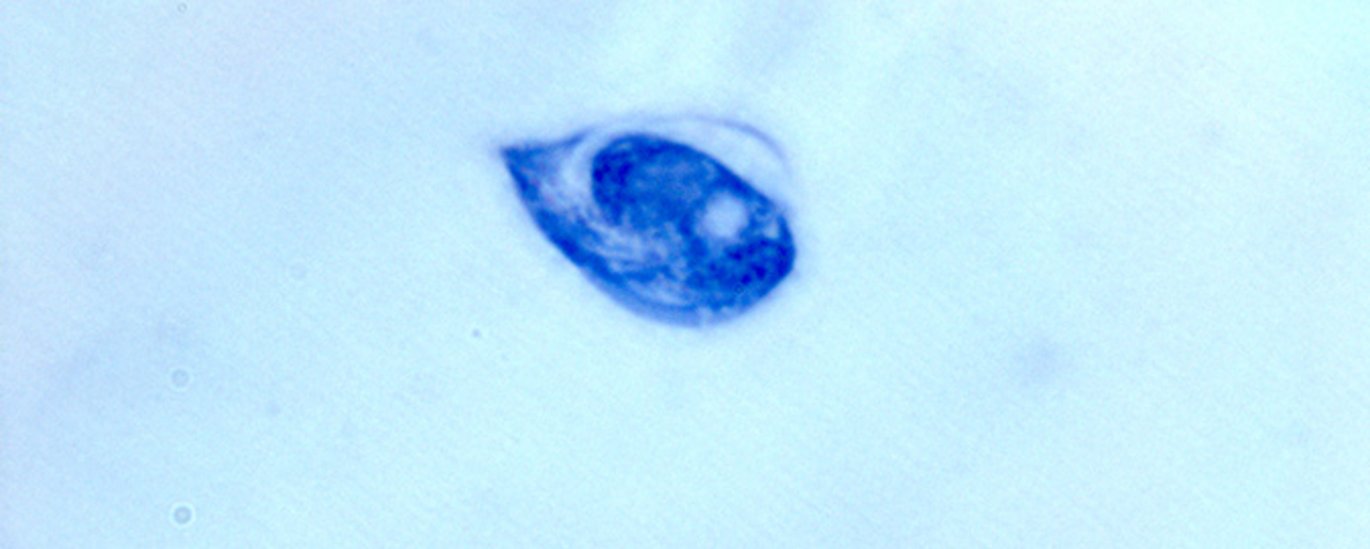A promising sustainable agent against a tough parasite in rainbow trout
The skin-parasite Ichthyobodo (Costia) is one of the most challenging parasites to control in farming of organic rainbow trout. However, a new sustainable agent against this parasite may contribute to secure welfare and health in organic trout.

The external surfaces of a fish includes skin, fins and gills and all parts may serve as attachment and living place for several parasites. Placed on the surface of the fish they are termed ectoparasites – or just skin parasites. Several types of these ectoparasites attack organic farmed rainbow trout, but Ichthyobodo necator is one of the worst.
The overall aim of Organic RDD 4 project, Shelterfish, is to improve welfare and health in organic rainbow trout. One specific focus is to control infections with the ectoparasite Ichthyobodo necator – also often termed Costia necatrix.
The ectoparasite Ichthyobodo (Costia)
Ichthyobodo is a small one-cell organism (10 thousandths of a millimeter in length) with two beating threads (flagelles), used for moving from fish to fish. Ichthyobodo may attack most freshwater fish, as it is not particularly specific, but in Denmark, the parasite is a big challenge for farming of rainbow trout. However, it occurs in two forms:
- In a motile bean formed stage
- In an attached pear-shaped stage, which assimilate food from the skin
In particular, the attached type hurts the fish, as the basal part of the parasite is firmly attached to the outer skin, called epidermis. The parasite may occur in huge numbers on skin, fins and not least the gills of rainbow trout. "On the surface of a 2-3 gram trout we counted 142,000 parasites. It is certainly a stressful burden to the fish and in the microscope we can see, that it causes an inflammatory reaction in the skin, which slightly swells and increases the production of mucus. Due to the attack the fish appears grey and dark, it moves more slowly and the wellbeing of the fish is severely challenged", explains Kurt Buchmann, who works at the Laboratory for Aquatic Pathobiology, Department of Veterinary and Animal Sciences at University of Copenhagen, Frederiksberg C, Denmark.
Current methods and opportunities
No vaccines against the infection are available; hence active substances are most often added to the water. Traditionally, the pond water has been treated with formalin to control the Ichthyobodo-parasite. The effect is good up to concentrations of 80 mg/l, but formalin cannot be used ad libitum in organic trout farms. It may only be used to a limited extent as a medicament in organic trout farm.
Alternatively, peracedic acid may be used (0.3 mg/l) and sodium-percarbonate (up to 120 mg/l) against the parasite in the ponds. Hydrogen peroxide in higher concentrations may also be applied, but it may have negative impact on the fish welfare, and it is not recommended as first choice.
A new anti-parasitic agent against Ichthyobodo
In the Shelterfish project a new bacterial surfactant, produced by the bacteria Pseudomonas H6, is investigated to control the infection with Ichthyobodo. In parallel, it is investigated whether plant extracts (f.ex. garlic) may have similar anti-parasitic effect.
"In a previous study we tested the agents against the so-called ”fish killer” eliciting ”white spot disease”, Ichthyophthirius, and it was shown, that the plant extracts f.ex. garlic and oregano as well as the mentioned surfactant had good effect. Based on these results we have high expectations that the new agents also may be used to control Ichthyobodo. Further, we have tested the agents against amoebae from trout gills with great success. If we can show that it has the same effect on Ichthyobodo, it may give new hope to organic farmers. Then the next step will be to achieve approval of the product for the purpose, whereafter it can be applied to sustainable control of ectoparasites”, explains Kurt Buchmann.
Link to scientific article on sustainable agents against amoeba from the gills of trout (free access to the abstract)